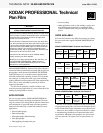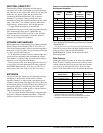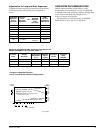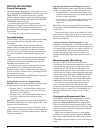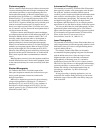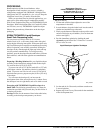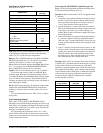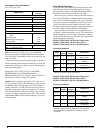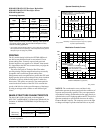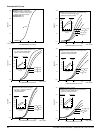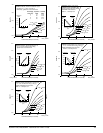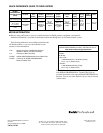
4 KODAK PROFESSIONAL Technical Pan Film • P-255
SPECIFIC APPLICATIONS
Pictorial Photography
These films produce high-quality pictorial negatives when
processed in KODAK TECHNIDOL Liquid Developer. (See
“PROCESSING.”) Conventional developers generally
produce contrast too high for normal pictorial photography.
Process the film according to the instructions for KODAK
TECHNIDOL Liquid Developer.
In pictorial applications, the fine grain permits
enlargements at magnifications of 25X or more with little
perceptible grain. The extended red sensitivity has a
haze-cutting effect in photographs of distant landscapes and
in aerial shots.
Use an exposure index of 25 for trial exposures.
Copy Applications
You can use these films for copying printed material, making
reverse-text title slides, and copying continuous-tone
photographs.
Use two lamps. Place one on each side of the copy
material so that each light strikes the material at about a
45-degree angle. For originals larger than 16 x 20 inches
(40 x 50 cm), you may need four lamps (two on each side)
for uniform illumination. Determine the exposure with a
meter.
If you use a camera with a through-the-lens meter, take the
reading from a gray card in the copy position. The meter
could give you an incorrect reading from the copy itself,
depending on the amount of text.
If you do not use an exposure meter, try these starting
points: With two No. 2 photolamps in matte-surface
reflectors at about 4 feet (1.2 metres) from the copyboard,
use 1/60 second at ƒ/8. With two No. 1 photolamps, increase
the exposure by one stop.
With meters marked for ISO (ASA/DIN) speeds or exposure
indexes, use these film-speed values:
Starting-Point Exposures for Copying Printed
Materials: With meters marked for ISO (ASA/DIN) speeds
or exposure indexes, use these film-speed values:
• Tungsten 320/26°—for incident-light readings or for
reflected-light readings from a gray card (18-percent
reflectance) at the copyboard.
• Tungsten 64/19°—for reflected-light readings from a
matte white card (90-percent reflectance) at the
copyboard.
Note: These values are based on small-tank development in
KODAK Developer D-19 for 4 minutes at 68°F (20°C) with
agitation at 30-second intervals.
The exposure index is based on the formula EI = 36/H,
where H is the 1-second exposure in lux-seconds required to
produce a density of 1.20 above minimum density with the
indicated development.
Starting-Point Exposures for Making Reverse-Text
Slides: With exposure meters marked for ISO (ASA/DIN)
speeds or exposure indexes, use these film-speed values:
• Tungsten 200/24°—for incident-light readings or for
reflected-light readings from a gray card (18-percent
reflectance) at the copyboard.
• Tungsten 40/17°—for reflected-light readings from a
matte white card (90-percent reflectance) at the
copyboard.
Note: These values for reverse-text slides are based on
development in KODAK DEKTOL Developer for 3 minutes
at 68°F (20°C).
The exposure index is based on the formula EI = 10/H,
where H is the 1-second exposure in lux-seconds required to
produce a density of 0.60 above minimum density with the
indicated development.
Copying Continuous-Tone Photographs: To copy
continuous-tone photographs, use an exposure-index value
to achieve a gamma value between 0.6 and 1.0, depending on
the contrast of the original. For low-contrast originals, you
can try KODAK HC-110 Developer (Dilution B) for
6 minutes (EI 160); for higher-contrast originals, use
KODAK TECHNIDOL Liquid Developer for 9 minutes
(EI 25).
Microphotography (Microfilming)
The resolving power of Technical Pan Film allows
microfilming of most documents at reductions of up to 20X,
assuming that the copying lens is of high quality and is
carefully focused. The film plane and the plane of the
copyboard must be parallel to provide sharp focus over the
whole image area. When you photograph black-and-white
originals, use a green filter such as a KODAK WRATTEN
Gelatin Filter No. 58 or 61. This will help suppress the
chromatic aberrations found in most lenses that would be
emphasized by the extended red sensitivity of the film.
For optimum image quality, adjust the exposure to
achieve a negative density of 1.20 in the areas that
correspond to the white or light-colored areas of the original.
Process the film to a gamma of 2.0 in KODAK HC-110
Developer (Dilution D) for 8 minutes at 68° F (20°C)
(EI 125).
Photographing Electrophoretic Gels
Electrophoretic gels are often photographed to produce
prints for information storage, analysis, display, and
publication. KODAK PROFESSIONAL Technical Pan
Films yield high-quality black-and-white negatives from
which you can make high-quality prints of these gels. Adjust
exposure carefully to minimize the appearance of the gel
background tint in the prints.
Make tests to determine exposures for your lighting
conditions. Develop the film for 4 minutes in KODAK
HC-110 Developer (Dilution D) at 68°F (20°C) (EI 80).
TECHNIDOL Liquid Developer may also work with your
setup.



